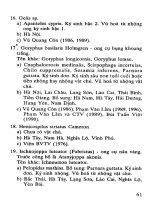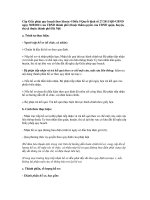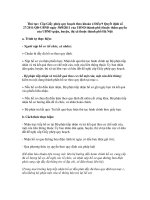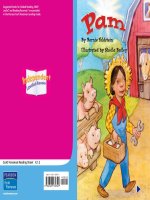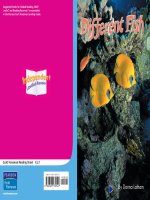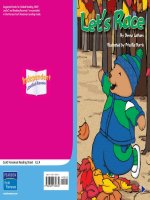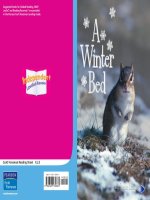- Trang chủ >>
- Mầm non - Tiểu học >>
- Lớp 5
5 2 4 saving endangered species (life science) TG
Bạn đang xem bản rút gọn của tài liệu. Xem và tải ngay bản đầy đủ của tài liệu tại đây (115.45 KB, 4 trang )
Saving Endangered
Species
SUMMARY
Many animals are in danger of
extinction due to overhunting, pollution, and
other human actions. The author explains
what people are doing today to ensure that
California condors, Bengal tigers, and other
endangered animals will not disappear from
Earth forever.
LESSON VOCABULARY
conservationists
extinct
population
species
endangered
habitats
scavenger
threatened
5.2.4
FACT AND OPINION
ASK QUESTIONS
READ THE BOOK
SET PURPOSE
Have students set a purpose for
reading Saving Endangered Species. Students’
own interest in this topic, as well as their
experiences and knowledge of animals, should
guide this purpose. Read aloud the title and
ask volunteers to share any questions it may
inspire. Why are animals worth saving and
what is being done to save them?
STRATEGY SUPPORT: ASK QUESTIONS
INTRODUCE THE TITLE AND AUTHOR
KWL is one
of the most useful ways of teaching students
how to ask questions. Before reading, create
a three-column chart with the headings What
I Know, What I Want to Know, and What I
Learned. Ask students what they already
know about endangered animals and come up
with questions about what they would like to
know about them. During their reading, have
students look for answers to their questions
and tell what they have learned. Record all
responses in the appropriate columns.
BUILD BACKGROUND
COMPREHENSION QUESTIONS
PREVIEW/USE TEXT FEATURES
PAGE 8 How does the Endangered Species Act
help certain animals? (It protects them from
hunting, collecting, and other harmful activities.)
INTRODUCE THE BOOK
Discuss with
students the title and the author of Saving
Endangered Species. What does it mean to
be endangered? Ask students to look at the
cover photo of the eagle and talk about how
the title relates to it. What other animals
might the author tell them about?
Have students discuss
their knowledge of animals that became
extinct due to natural events or human
activities. Then ask them to share what they
know about animals facing extinction today
and why.
Ask students how
pairing photos of animals with images of their
natural habitats can enhance one’s understanding of endangered animals.
Use visual aids such as maps or
globes to show students where animals such
as the California condor, Andean condor, and
grizzly bear live.
44
PAGE 5
Why do some species of animals and
plants become extinct? (They become extinct
because of human actions such as hunting,
polluting, and cutting down forests.)
PAGE 16
How does the saving of wild lands
help save animals? (Wild lands provide a home
where animals can survive and thrive.)
PAGE 21
Is the author stating a fact or opinion
when she writes that endangered animals are
“some of nature’s most beautiful and amazing
creatures”? (She is stating an opinion, because
it tells about her feelings and cannot be proven
true or false.)
Saving Endangered Species
16924_LRD_TG_044-045 44
12/28/05 1:43:32 PM
REVISIT THE BOOK
READER RESPONSE
1. Possible response: An asteroid caused the
extinction of plants and dinosaurs.
2. Answers will vary but might include questions about how much land the corridors
take up, how close they are to cities, and
how they’re guarded.
3. Possible responses: conserving water;
learning about endangered species;
cleaning up a beach, park, or yard
4. Possible response: The grizzly bear’s habitat
has shrunk a great deal over time.
EXTEND UNDERSTANDING
Tell students that
captions appear next to photographs or
illustrations to explain what is shown in
them. Ask them to examine carefully the
photographs and captions in the book and talk
about the information they provide. Then have
students use reference sources to gather
additional facts about animals shown in the
photographs. They can use this information to
supplement existing captions.
RESPONSE OPTIONS
WRITING
Have students adopt an endangered
animal’s point of view and write a journal entry
detailing its hopes, fears, and daily life.
SCIENCE CONNECTION
Discuss how saving
endangered animals and
their habitats can support life
for all of Earth’s living creatures.
How might the extinction of one animal
affect the lives of others in its environment?
Have students use reference sources to find
answers.
Skill Work
TEACH/REVIEW VOCABULARY
Ask each volunteer to take a vocabulary
word and point out how it is used in the
book. Then ask questions about each word,
such as, As a scavenger, what kind of food
does the California condor eat?
TARGET SKILL AND STRATEGY
FACT AND OPINION Explain that a
statement of fact can be proven true or
false by reading, observing, or asking an
expert. A statement of opinion is a judgment
or belief that cannot be proven true or false
but can be supported or explained. Draw a
T-chart on the board and label one column
Statements of Fact and the other Statements
of Opinion. Then ask students to discuss
what they know about endangered animals
and point out which of their statements
belongs in which column.
ASK QUESTIONS Asking questions helps
readers actively engage with text and
remember important ideas. Tell students that
a good question often starts with a question
word, such as who, what, when, where, why,
and how. It also asks about an important
detail of the story and can be answered in
the reading. Based on these criteria, ask
students to record questions they have while
reading about endangered animals.
ADDITIONAL SKILL INSTRUCTION
CAUSE AND EFFECT
Tell students that an effect
is something that happens, and a cause
is why that thing happens. Have students
practice by identifying the cause and
effect in simple sentences such as, I am
hungry because I skipped breakfast. (What
happened: I am hungry. Why it happened:
I skipped breakfast.) Then ask them to
identify cause-and-effect relationships when
they are reading about endangered animals.
Saving Endangered Species
16924_LRD_TG_044-045 45
45
3/20/06 8:46:01 AM
Saving Endangered Species
Name
Fact and Opinion
• A statement of fact can be proven true or false by reading, observing, or asking an expert.
• A statement of opinion is a judgment or belief. It cannot be proven true or false but can be
supported or explained.
Directions Read the following passage. Decide which sentences are statements of fact and
which sentences are statements of opinion. Then complete the chart below.
One animal that desperately needs its wild lands to be saved is the grizzly bear. The grizzly
bear is one of the largest animals in North America. Male grizzlies can stand on their hind
legs to a height of seven feet! They have been known to attack hikers, but that happens rarely.
Grizzlies probably have more reasons to fear people. Humans have destroyed much of their
habitat. Building roads through forests destroys grizzlies’ territory. Many bears are also killed
on these roads.
Statements of Opinion
© Pearson Education 5
Statements of Fact
46
16924_LRD_TG_046-047 46
12/28/05 1:44:30 PM
Saving Endangered Species
Name
Vocabulary
Directions Choose the vocabulary word that best matches each definition. Write the word
on the line.
Check the Words You Know
conservationists
habitats
species
endangered
population
threatened
extinct
scavenger
1. a group of organisms with common characteristics
2. no longer existing
3. all the living things of one kind in a single place
4. at risk of becoming endangered
5. an organism that eats dead animal matter
6. people who work to preserve natural resources
7. places where an animal or plant lives or grows naturally
8. in danger of becoming extinct
© Pearson Education 5
Directions Write a paragraph about endangered species using as many vocabulary words as you can.
47
16924_LRD_TG_046-047 47
12/28/05 1:44:32 PM

